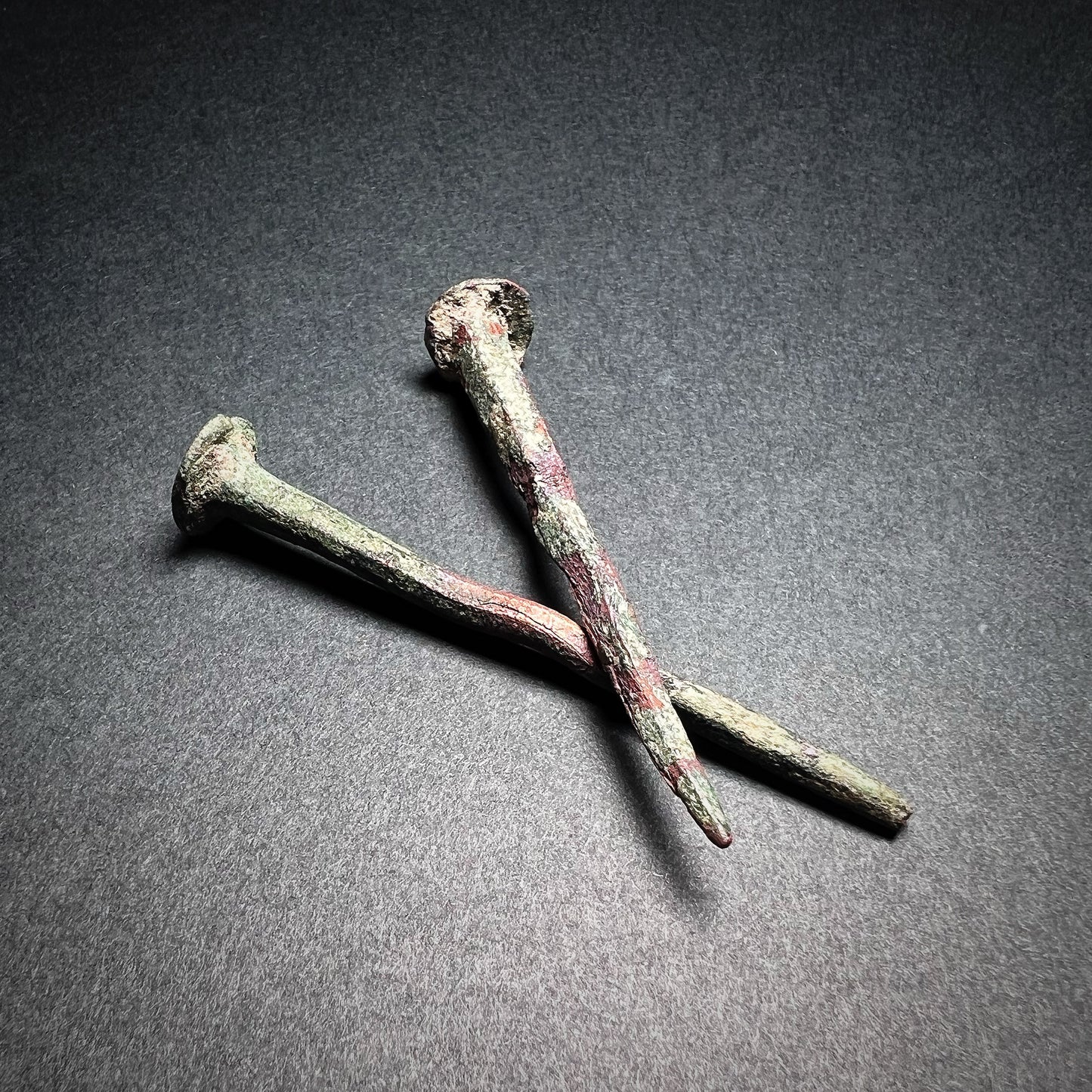Roman Bronze Nails
Roman Bronze Nails
Couldn't load pickup availability
The Roman Empire, c. 100-300 AD.
Lovely pair of Roman era nail, cast in bronze, featuring a cone shaped head and a four faceted, narrow body with a wantig or worn out tip. Cast copper alloy and iron nails of various sizes were made by the Roman legion's metalworkers in their workshop (fabrica) by smelting the ore and forming the nails by hand, producing a square tapered nails with a flattened pyramid shaped head. The larger nails were used to hold the wooden barrier around the fort in place. They were also used to secure the timber roofing of the fort buildings. The fortress at Inchtuthill, Perthshire, Scotland, had seven tons of iron nails left behind when the garrison was evacuated in 86-87 AD. There is also direct evidence that in the Roman world nails could be viewed as magical artefacts. They were sometimes inscribed with incantations or signs intended for religious or mystical benefit, used at shrines or on the doors of houses for protection. The Roman practice of "annual nail" (clavus annalis) and the nailing curse tablets (tabella defixiones) shows the importance of using nails in magico-religious context. Nails from tombs and crucifixions were sometimes even worn around the neck as talismans against fevers, malaria and evil spells.
Good condition. Intact. Age-related heavy wear. A fine green patina envelops in layers of mottled grayish hues. Mineral encrustation and corrosion. Size approx. 6,5cm x 1,1cm x 0,4cm and 6,4cm x 0,4cm x 1,1cm. Sell as a set.
Provenance: Swedish private collection.
For a similar examples see:
Copper alloy nail, Ashmolean Museum, University of Oxford, Accession Number: AN1871.111 (https://collections.ashmolean.org/object/587615)
Nail, The Metropolitan Museum of Art, Accession Number: 74.51.5364 (https://www.metmuseum.org/art/collection/search/244243)
Nail, The British Museum, Accession Number: 1975,0723.11 (https://www.britishmuseum.org/collection/object/G_1975-0723-11)
References and further reading:
Mystifying Roman Nails: Clavus Annalis, Defixiones and Minkisi, David Dungworth, Theoretical Roman Archaeology Journal, 1997, pp: 148–159 (doi: https://doi.org/10.16995/TRAC1997_148_159)
Magical practices? A non-normative Roman imperial cremation at Sagalassos, J. Claeys, K. Van de Vijver, E. Marinova, S. Cleymans, P. Degryse & J. Poblome, Antiquity, 2023; 97(391): 158-175. (doi:10.15184/aqy.2022.171)
In a Roman Tomb, ‘Dead Nails’ Reveal an Occult Practice, Franz Lidz, The New York Times, Science, March 25, 2023. (https://www.nytimes.com/2023/03/25/science/archaeology-ancient-rome-tomb.html)


-
Shipping
The shipment will be prepared in the course of 3-5 days and dispatched via Posti Group Oyj or purchased item(s) can be picked up from our shop during the store's opening hours (Tarkk’ampujankatu 4, 00140, Helsinki, Finland). Within the Finland, all items are shipped via Posti Group Oyj unless otherwise requested. We pack the items carefully and mainly in recycled materials because we want to save nature. You will receive the tracking number for your items by e-mail.
-
Returns
Returns and exchange will be accepted within fourteen days (14) of receipt at the purchaser’s cost to include freight and packaging. Items must be returned in the same condition as when they were shipped, and will not be accepted if damaged or altered in any way. Please inform us via email (info@gotanmaailma.fi) or by calling +358408408352 before sending. We do not accept returns more than 14 days after delivery.


